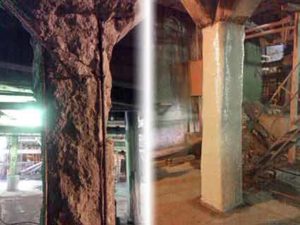Structural Reinforcement of Concrete: A Viable and Sustainable Solution The issue of structural reinforcement in concrete is a global challenge that transcends national boundaries. We frequently hear about the degradation of critical infrastructure components such as bridges, ports, and water pipelines. However, the root cause lies in the durability of concrete itself—specifically, the reinforced concrete containing iron and steel. Contrary to its historical reputation, concrete today is far less resilient than it once was. According to Robert Courland’s book, The Concrete Planet, Roman concrete structures have endured for over 2,000 years, whereas contemporary concrete may last a century at most. Additionally, cement production is the third-largest contributor to global CO2 emissions, surpassed only by automobiles and coal-fired power plants. Expanding our current infrastructure with additional concrete presents a significant environmental burden that cannot be overlooked. Fortunately, alternative solutions exist, such as carbon fiber reinforcement, which not only cuts costs but also mitigates environmental harm. Concrete reinforcement or replacement becomes essential when the structural integrity diminishes or requires enhancement. This could result from increased load demands or corrosion of the steel reinforcement embedded within the concrete. Minor cracks caused by vibrations from industrial operations or traffic, as well as thermal expansion during temperature fluctuations, can be addressed through repairs. However, when moisture, air, and chemicals infiltrate reinforced concrete, the embedded steel corrodes, expanding and causing the surrounding concrete to break apart. This phenomenon, known as spalling, weakens structures such as buildings, roads, bridges, dams, levees, homes, airports, sewage systems, schools, canals, power plants, grain silos, piers, and tunnels, compromising their longevity. Repairing concrete is an eco-friendly alternative to outright replacement because it conserves energy. Cement production is highly energy-intensive, requiring vast amounts of coal during the process. The World Coal Association notes that each ton of cement generates approximately one ton of CO2, with some cases exceeding this amount. The environmental toll of producing additional concrete to meet infrastructure demands is substantial, especially given the reliance on fossil fuels. Carbon fiber reinforcement offers a forward-thinking solution for strengthening concrete structures. These materials are lightweight, easy to install, and do not impose additional weight on existing structures. They are also more sustainable than conventional steel and concrete repairs or replacements. HJ3’s carbon fiber systems represent a 60-90% cost-saving measure over full-scale replacement, extending the lifespan of infrastructure for decades. Furthermore, they minimize downtime, making them a popular choice for stakeholders. HJ3’s carbon fiber systems are widely utilized to reinforce columns, beams, walls, slabs, silos, pedestals, pilings, underground pipes, manholes, and concrete tanks. There are two primary approaches to reinforcing deteriorating concrete structures. The first involves replacing existing concrete infrastructure with new concrete, which is both energy-intensive and environmentally damaging. The second, more sustainable method, employs advanced composite systems like carbon fiber. Carbon fiber installation is faster, simpler, and more cost-effective when all factors—materials, transportation, permits, downtime, and labor—are considered. If you require concrete reinforcement and wish to explore HJ3’s repair systems, reach out to our project managers at [contact information]. In conclusion, addressing the challenges of concrete degradation is not just about preserving the physical integrity of structures—it’s about safeguarding the planet. By embracing innovative solutions like carbon fiber reinforcement, we can ensure the longevity of vital infrastructure while minimizing our carbon footprint. As awareness grows, so too does the urgency to adopt sustainable practices in construction. Together, we can build a future where durability meets environmental responsibility. Static Guide,Entrance Sliding Guide,Finish Rolling Export Sliding Guide,Hot Rolled Steel Entry Sliding Guides JINGJIANG EASTSUN METALLURGICAL MECHANICS CO.,LTD , https://www.jesguide.com

Repairing Our Concrete Planet